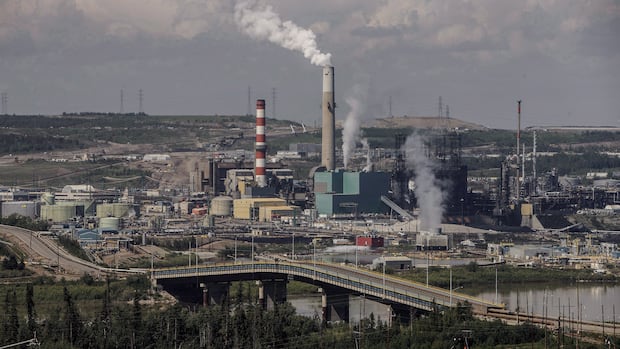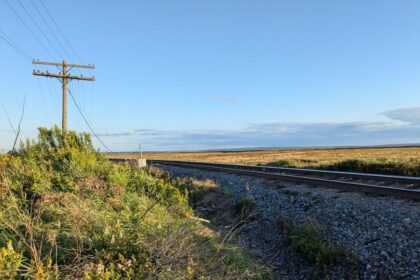CalgaryThere’s growing interest in the Canadian oilpatch coming from south of the border. Experts say the trend is driven in part by a shift in political rhetoric in this country, along with better economics for the Canadian oilpatch compared with the U.S.Shift in political rhetoric and better economics have investors taking closer lookPaula Duhatschek · CBC News · Posted: Oct 20, 2025 4:00 AM EDT | Last Updated: 8 hours agoExperts say U.S. investors are increasingly eyeing Canadian oilsands companies. The Cenovus Christina Lake oilsands facility, southeast of Fort McMurray, Alta., is shown in April 2024. (Amber Bracken/The Canadian Press)There’s growing interest among U.S. investors in the Canadian oilpatch, a trend driven by friendlier rhetoric from the federal government and a belief that the industry north of the border will more reliably return cash to them in the years ahead.Jeremy McCrea, a Calgary-based managing director at BMO Capital Markets, described the trend as a “rotation,” with more investment coming from the United States and a slight decline from Canada.While lower oil prices have generally put a bit of a damper on investment, many portfolio managers still want to hold some energy stock and see more potential in the Canadian sector compared with the U.S., he said.“You are seeing more U.S. investors saying, ‘If we have to hold energy, we’d rather hold Canadian energy here today,’” McCrea said.U.S. funds now own about 59 per cent of Canadian oil and gas companies, up from 56 per cent at the end of last year, he said. Meanwhile, Canadian ownership of these companies has dipped from 37 per cent to 34 per cent. Suncor’s base plant with upgraders is shown in Fort McMurray in June 2017. Oilsands operations are expensive to build upfront but can run for decades at a stable cost. (Jason Franson/The Canadian Press)CEOs in the Calgary oilpatch are seeing the trend play out in their own companies.Grant Fagerheim, CEO of Whitecap Resources, said currently about 66 per cent of his company’s institutional holders are in the U.S., up from roughly 60 per cent at the end of last year.“That’s quite remarkable,” he said.Brian Schmidt, CEO of Tamarack Valley Energy, said he believes there’s still some hesitation from Canadian investors, particularly pension funds, about investing in the oil and gas sector but that U.S. investors don’t feel the same reluctance.If he’s visiting an American city, “I can fill one or two days full of meetings,” Schmidt said. “I’m not able to do that in Canada.”He estimated that U.S. ownership of his company is now about 40 per cent, up from 20 per cent prior to the COVID-19 pandemic. A change in toneThe shift in investment started ramping up about a year ago, McCrea said, at which point the federal Conservatives were leading in the polls and promising major policy changes to boost the oil and gas sector.While the federal Liberals were ultimately re-elected, Prime Minister Mark Carney promised in his election night speech to make Canada an energy “superpower.”WATCH | Carney on his vision for Canada’s energy sector:Carney says ‘more will be done’ on energy, but conversation isn’t all about pipelinesAsked by CBC’s Power & Politics host David Cochrane about the separatist sentiment in Alberta, Prime Minister Mark Carney says his government is ‘committed’ to working with Canadians across the country.“There is a bit of a change of tone that is making investors a little bit more comfortable coming into Canada,” McCrea said.Schmidt said the completion of the Trans Mountain Pipeline expansion has also ramped up interest from investors by boosting the sector’s export capacity.Part of the uptick in interest is also driven by the relative economics of the oilpatch in Canada versus the U.S.In the U.S., most oil production still comes from oil wells. Once wells are depleted, new ones have to be drilled. This costs money and might not be worth it to companies depending on the price of oil.A recent survey of U.S. oil companies found that most needed a price of about $65 US per barrel to justify drilling a new well. Oil prices, meanwhile, are expected to be less than $60 US/barrel through the end of this year and average near $50 US/barrel through 2026, according to the U.S. Energy Information Administration.Earlier this month, the CEO of one of the top oil producers in the U.S. said he expects production in his country will likely stall out if the price of oil continues to hover at its current rate.‘Attractive’ future for oilsandsThe economics of drilling new wells in the U.S. have been getting worse as the country’s top oilfield, the Texas-based Permian Basin, has become increasingly depleted. It’s now producing more water and gas and less oil, which means new wells are likely to generate diminishing returns.In comparison, much of Canada’s oil production happens in the oilsands. Oilsands projects are expensive to build upfront, but once complete, they can run at a low cost for several decades.The Suncor Energy Centre in Calgary. In recent years, Canadian oilsands companies have focused on returning money to shareholders rather than spending on new capital projects. (Jeff McIntosh/The Canadian Press)In recent years, oilsands companies in Canada have been less focused on building new oilsands projects and have instead opted to return more money to shareholders, which is appealing to investors on both sides of the border.“We see these companies generating a lot of cash and returning almost all of it to the shareholders,” said David Samra, a Boston portfolio manager with Milwaukee-based investment firm Artisan Partners, which is invested in Suncor Energy.“That’s the future that we see, and we find that future to be very attractive.”McCrea, with BMO Capital Markets, said it’s not clear just how much bigger this trend might get, but on the whole, the future seems to look “encouraging.”As for Fagerheim, with Whitecap Resources, he said he believes investors in Europe and Asia, like their counterparts in the U.S., are increasingly eyeing the Canadian oilpatch.“The world has taken notice as well,” he said.ABOUT THE AUTHORBorn and raised in Calgary, Paula Duhatschek is a CBC Calgary reporter with a focus on business. She previously ran a CBC pop-up bureau in Canmore, Alta., and worked for CBC News in Toronto, Kitchener and in London, Ont. You can reach her at paula.duhatschek@cbc.ca.
Why U.S. investors are eyeing the Canadian oilpatch, even as oil prices dip











